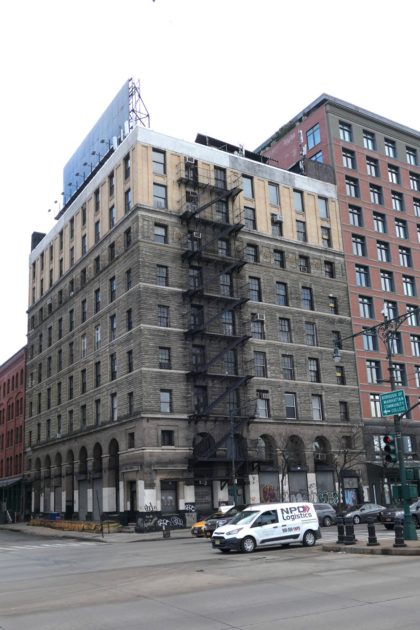In the News: The Next Chapter for a Controversial Conversion
 ••• I’ve been wondering what’s been going on at 67 Vestry for years, and now we know: Aby Rosen’s RFR Realty sold it to Iliad Realty Group for $55.5 million, says the Commercial Observer. “The second through ninth floors of the 61,250-square-foot former warehouse are divided into 25 apartments, according to marketing materials from Cushman & Wakefield. Of the 25 loft units, a few are still occupied by rent-stabilized tenants, but the majority are vacant, according to C&W’s Robert Knakal, who helped broker the sale. Fourteen units are rent stabilized, according to the most recent property tax bill.” The majority of the 25 residential units are vacant, but 14 are rent-stabilized? “The property also has 7,000 square feet of vacant ground-floor retail, the brochure from C&W notes. RFR purchased the building for $16.5 million in 2005, property records indicate. The company filed plans to build an 11-story, 42-unit residential building on the site in 2014. However, it looks like the developer abandoned the project after 67 Vestry’s stabilized residents fought the development plans and attempted to get the building landmarked.”
••• I’ve been wondering what’s been going on at 67 Vestry for years, and now we know: Aby Rosen’s RFR Realty sold it to Iliad Realty Group for $55.5 million, says the Commercial Observer. “The second through ninth floors of the 61,250-square-foot former warehouse are divided into 25 apartments, according to marketing materials from Cushman & Wakefield. Of the 25 loft units, a few are still occupied by rent-stabilized tenants, but the majority are vacant, according to C&W’s Robert Knakal, who helped broker the sale. Fourteen units are rent stabilized, according to the most recent property tax bill.” The majority of the 25 residential units are vacant, but 14 are rent-stabilized? “The property also has 7,000 square feet of vacant ground-floor retail, the brochure from C&W notes. RFR purchased the building for $16.5 million in 2005, property records indicate. The company filed plans to build an 11-story, 42-unit residential building on the site in 2014. However, it looks like the developer abandoned the project after 67 Vestry’s stabilized residents fought the development plans and attempted to get the building landmarked.”
••• The Broadsheet has a thorough look at the Water Street arcade landgrab, in which the city is handing back public space to the commercial real-estate industry. You should read the whole thing, but if you just can’t/won’t, read this summary regarding the first arcade to be reclaimed:
In the case of 200 Water Street, the original “floor-area ratio” (FAR) permitted for the site was 10.0, meaning that the developer had the right to construct a tower that had a square footage ten times the size of the lot on which the structure was built. This would have allowed for a building with 334,000 square feet of interior space. But, in exchange for adding arcades and a plaza at the building’s entrance, the original developers were permitted to increase the size of 200 Water Street by 61 percent, to 541,000 square feet. The financial upside from this extra space—in terms of both increased rental income each year since the building opened in 1973 and increased overall value to the building—is almost impossible to calculate. But it can be reasonably assumed to range in the tens of millions of dollars, if not more than $100 million. With the additional upside that landlords may now reap, by enclosing arcades and taking over plaza space, it is possible that property owners will be compensated a second time (in this instance for partially privatizing the public amenity they once created) and perhaps reap a windfall of millions more.
••• “WeWork is quietly recruiting startups to a new project called Area 51 Paradise Ranch [….] The invite-only program is meant to be an incubator and ‘launchpad’ for startups. Despite its Nevada-oriented name, Area 51 will start with a ‘beta’ program at WeWork’s [205] Hudson Street office space in New York City. WeWork declined to comment on the project, which is still being developed.” —Wired














Anyone know what the top of 67 Vestry looked like, back in the day? Must have been nicer than what’s up there now. And I wonder if Landmarks is okay with that billboard on the roof?
At the link is a c. 1900 Wurts Bros. photograph showing 67 Vestry Street prior to the two story addition.
http://collections.mcny.org/Collection/%5BIndustrial%20building,%20West%20Street%20and%20Vestry%20Street.%5D-2F3XC5B_D.html
https://images-na.ssl-images-amazon.com/images/I/51twi1l3YZL.jpg
Cover art from Laurie Anderson – Big Science c. early 1980s